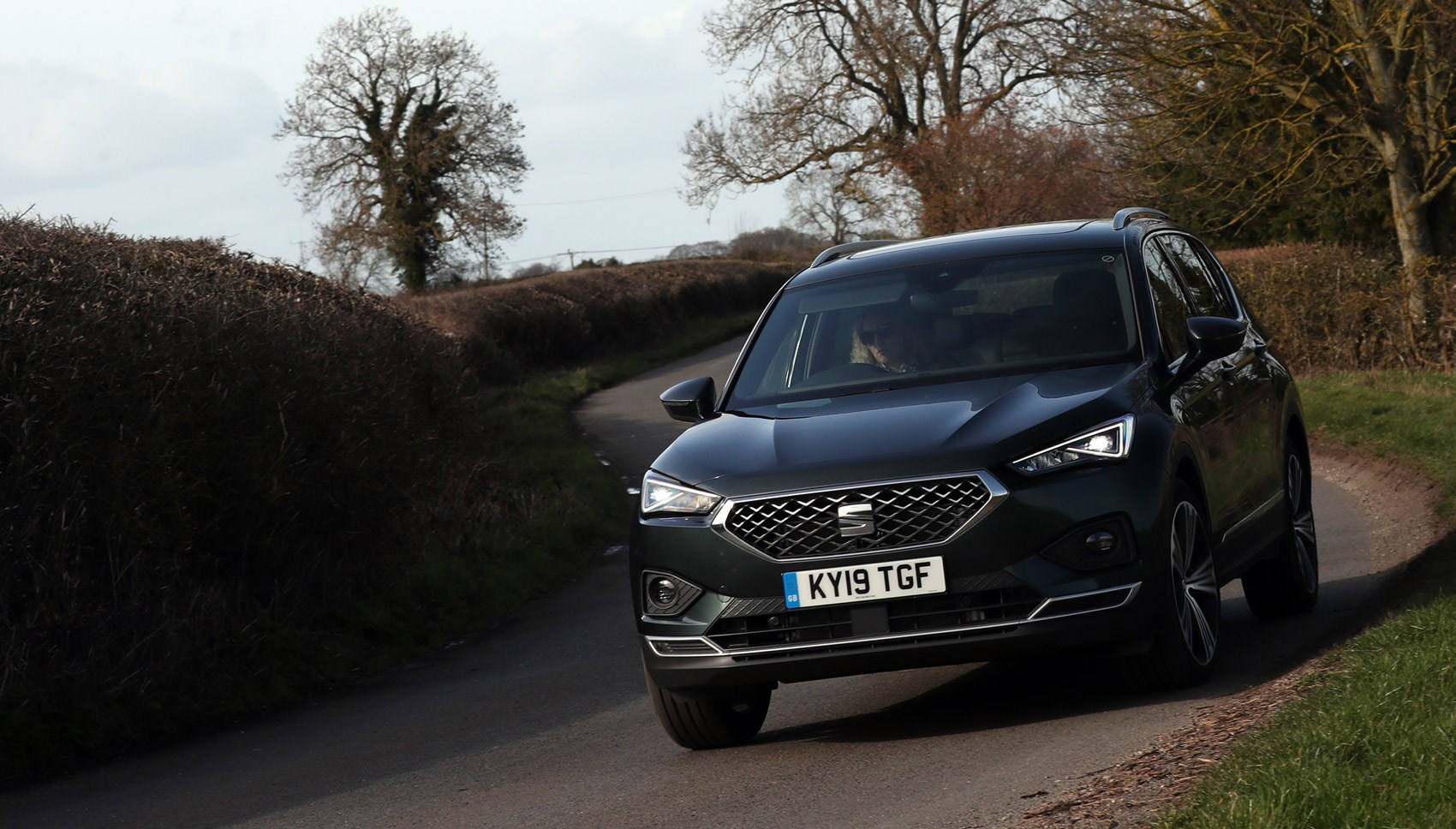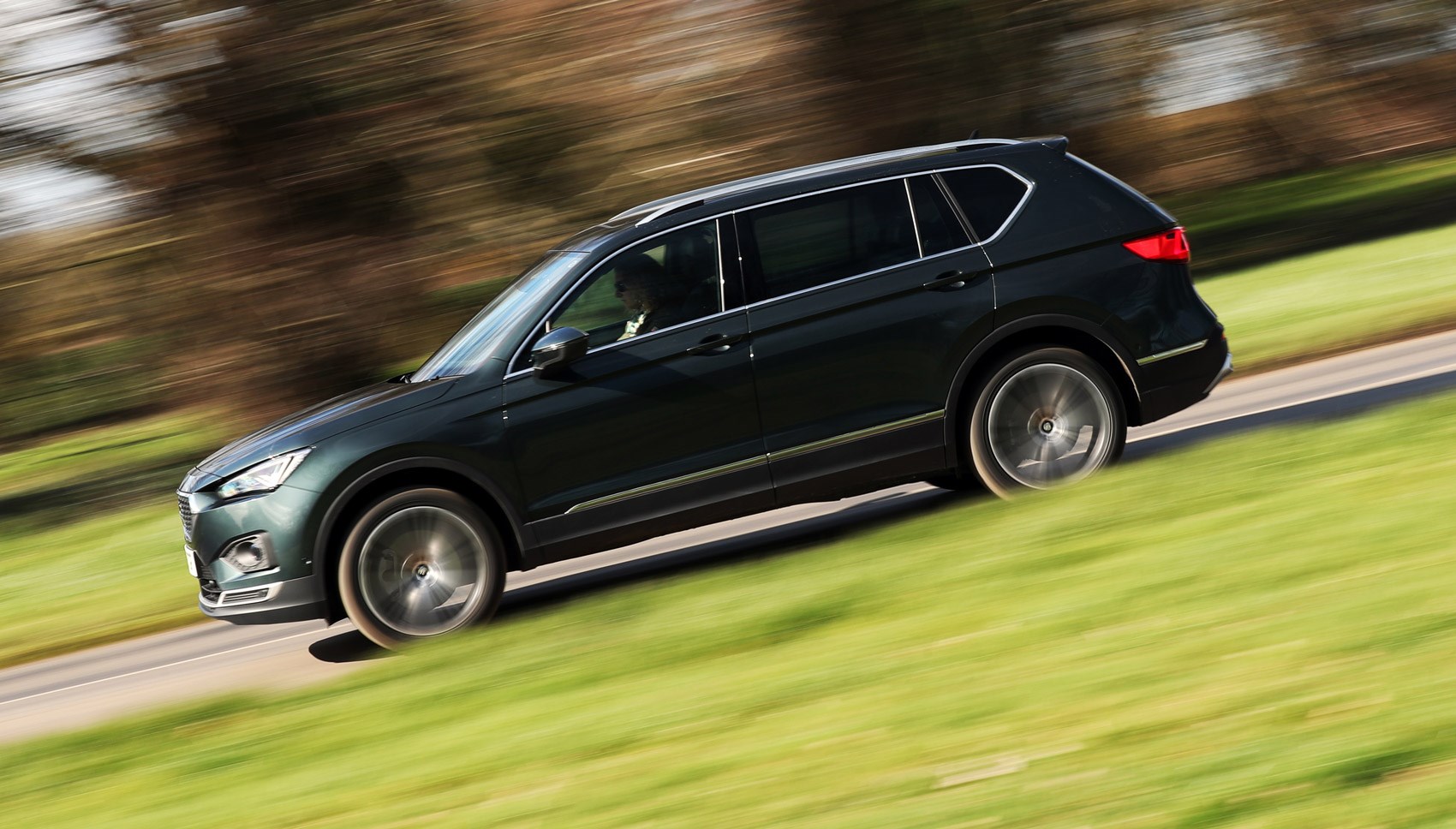► New Seat Tarraco SUV review
► Petrol and diesel models tested
► Sits above Ateca and Arona
Cast your eyes across the chiselled lines of the new Seat Tarraco. If you’re in the market for a seven-seater SUV, but don’t want to sacrifice sportiness, then the Spanish marque claims the Tarraco is the answer to your needs.
Sounds like an enticing combination that might prevent you from signing on the dotted line for a Hyundai Santa Fe, Kia Sorento or a Peugeot 5008, let alone the Skoda Kodiaq and Volkswagen Tiguan Allspace.
Now, given the Tarraco shares so much with those latter two cars, we asked Andrew Shepherd from Seat’s Technical Center what the key differences were. His response was that first and foremost the Tarraco had Seat-specific tuning to its handling characteristics, but that it was also styled more sportily than its in-house relations.
Our guide: the best luxury SUVs
What engines does the Tarraco have?
The current UK line-up starts with a 1.5-litre turbocharged petrol four that makes 148bhp. It’s a very familiar engine from the current VW Group line-up, and one that’s highly acclaimed. It is, for instance, the pick of the Arona engines. But the Tarraco weighs about 400kg more than the Arona. How does it cope in the seven-seater? Not at all badly, in truth, so long as you adjust your expectations. Some of the punchier engines live up to Seat’s talk of the Tarraco being a sporty SUV, but this smallest engine works on an entirely different basis: as the motive force for smooth, easygoing family transport.

That engine is available only in front-wheel-drive Tarracos, but you get a choice of six-speed manual or seven-speed DSG auto, both offering clean changes, sub-10-second 0-62mph times and fuel consumption in the mid-30s.
Elsewhere, despite the 8.0-second 0-62mph time and 187bhp of grunt, the 2.0-litre TDI diesel-engined Tarraco doesn’t feel as quick as the statistics suggest it might. In part it feels leaden due to its DSG transmission: while it swaps cogs readily enough, its initial responsiveness from standing starts is a tad sluggish, with the shortfall made up by the diesel’s low-down torque.
What’s the Tarraco like to drive?
Driving the Tarraco back to back on UK roads with the VW Tiguan Allspace and Skoda Kodiaq, its VW Group siblings, it’s clear that Seat’s talk about different suspension settings is not just hot air. There’s variation from model to model, of course, and much depends on your choice of wheel size, but as a rule of thumb the Seat will be the firmest of the three, but not in a harsh way. There’s less of a wallowy sensation during cornering, and a more engaged feel for the driver, while still being perfectly comfortable for all on board.

So far we’ve only driven the Tarraco on Spanish highways smoother than Leslie Phillips in his 1950s pomp – ding dong. The asphalt was further complemented by the test cars being fitted with Dynamic Chassis Control (adaptive suspension), which helps negate the effect of 20-inch rims and low-profile rubber. Traction’s strong – especially in the 4Drive all-wheel drive models (as expected) – the steering’s sharp and weightier on the TDI diesel than the TSI petrol and bodyroll is tautly controlled.
And what about that sporty styling?
How a car looks is entirely subjective, but given the size of this particular SUV canvas, it’s disappointing how similar it looks to the Skoda and VW alternatives.
Perhaps Dieselgate-related cost-cutting has stymied the design team’s creativity but minus the grille and lighting graphics, the Seat and its cousins could be alternative design proposals for the same car. Shame.
More significant than claims of visual athleticism is that the Tarraco is said to be a styling bridge between the rest of Seat’s current line-up and the all-new Leon.
Of particular note is the more imposing, vertically-set grille garnished with a thick chrome frame, flanked by smaller-than-usual headlamps featuring a revamped LED lighting signature. In fact, all of the Tarraco’s lighting is courtesy of LEDs, aside from that red bar linking the tail lamps – it’s nothing more than a unilluminated decorative fillet.
Are you going to pretend the connectivity features are sporty?
No. No, we’re not.
That’s not to say that the connected features aren’t useful – and voice-activation should be safer than prodding the touchscreen – but they don’t enhance the performance.
You’ll doubtless have noticed that the Tarraco’s also ushered-in a new style of dashboard for Seat, although it doesn’t look dissimilar to the one in the upcoming Skoda Scala hatch. Gone is the integrated touchscreen designs of the Arona and Ateca, replaced by a floating-look item. And it is only a look, with the rear of the frame chamfered away out of view, rather than a unit protruding from the dashboard as with the Peugeot 5008.
Trim finishes on our Xcellence-grade test example include plastiwood – if it’s real timber, a remarkable job has been done of making it look and feel fake – along with a twill-type of upholstery, gussied-up with some Alcantara, sueded-effect panels.
If it’s not exactly sporty, does the Tarraco succeed as a seven-seater?
Like its rivals, while there are seven seats (Britain misses out on the five-seat version), the rearmost pair are only really sufficient for kids.
They fold and raise easily within the capacious boot, though, while everything feels sufficiently sturdy for the rigours of family life. As with its VW Group relations, the Tarraco loses out to the 5008 in the middle row as well. Although it’s roomy enough, the Peugeot feels positively palatial by comparison and has the bonus of being fitted with three individually adjustable seats – it’s an MPV by stealth.
It’s rather a telling point that the shuttle vehicles back to the airport following the press launch weren’t Tarracos, but older, spacier and far less fashionable Alhambras…
Seat Tarraco: the verdict
Seat’s definitely got a fine contender on its hands in the seven-seat SUV segment, but it doesn’t feel like an improvement over the Kodiaq or Tiguan Allspace, just an alternative to them.
That in itself doesn’t make it bad, just that it lacks any cleverly evolved features or more overt sportiness. Cookie-cutter cars don’t move the genre on, which ultimately isn’t in consumers’ best interests.
More Seat reviews by CAR magazine